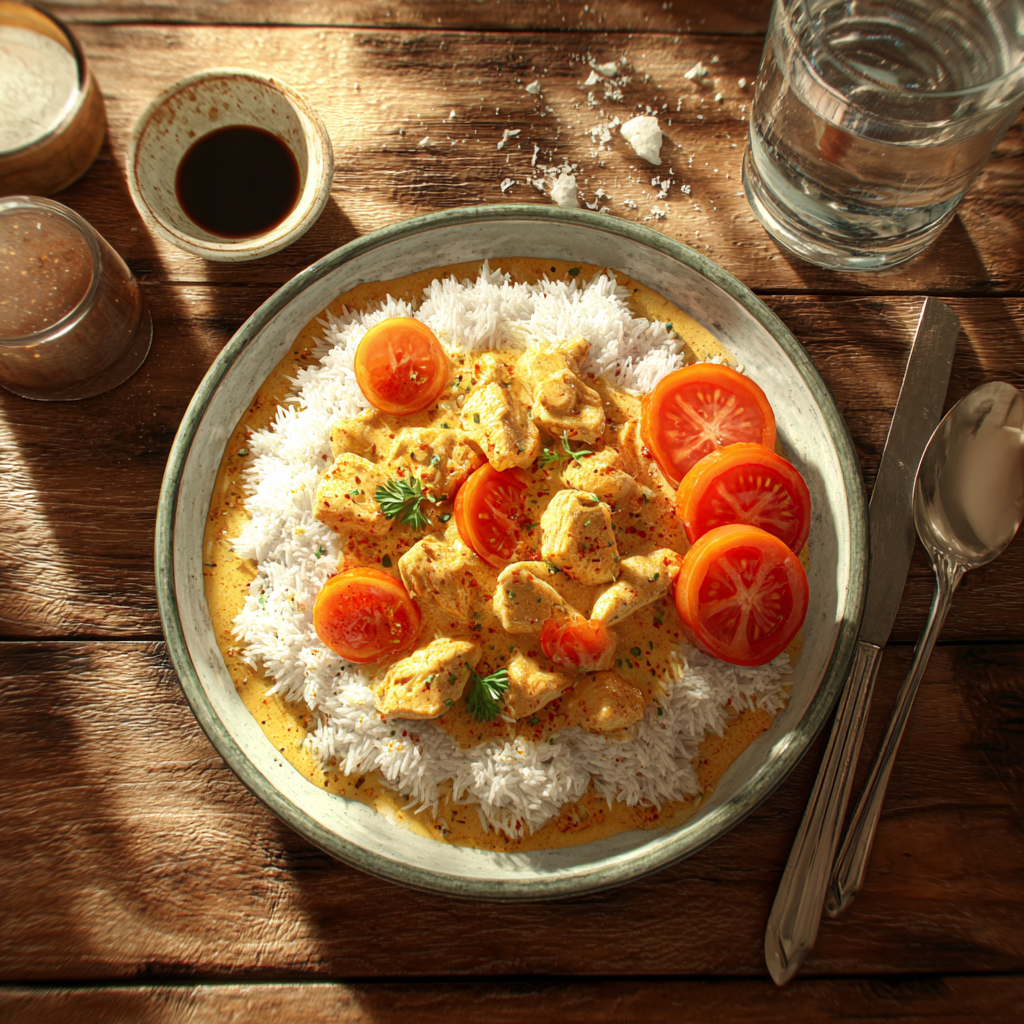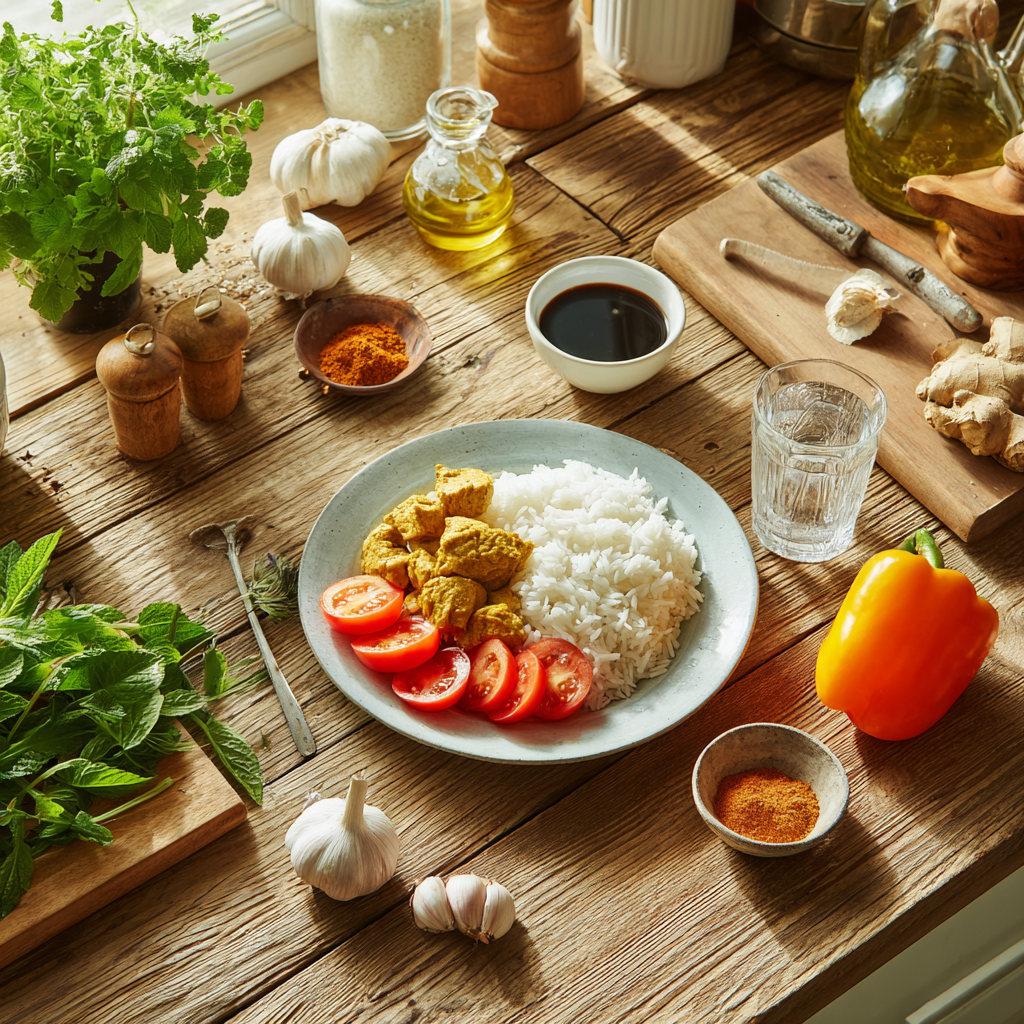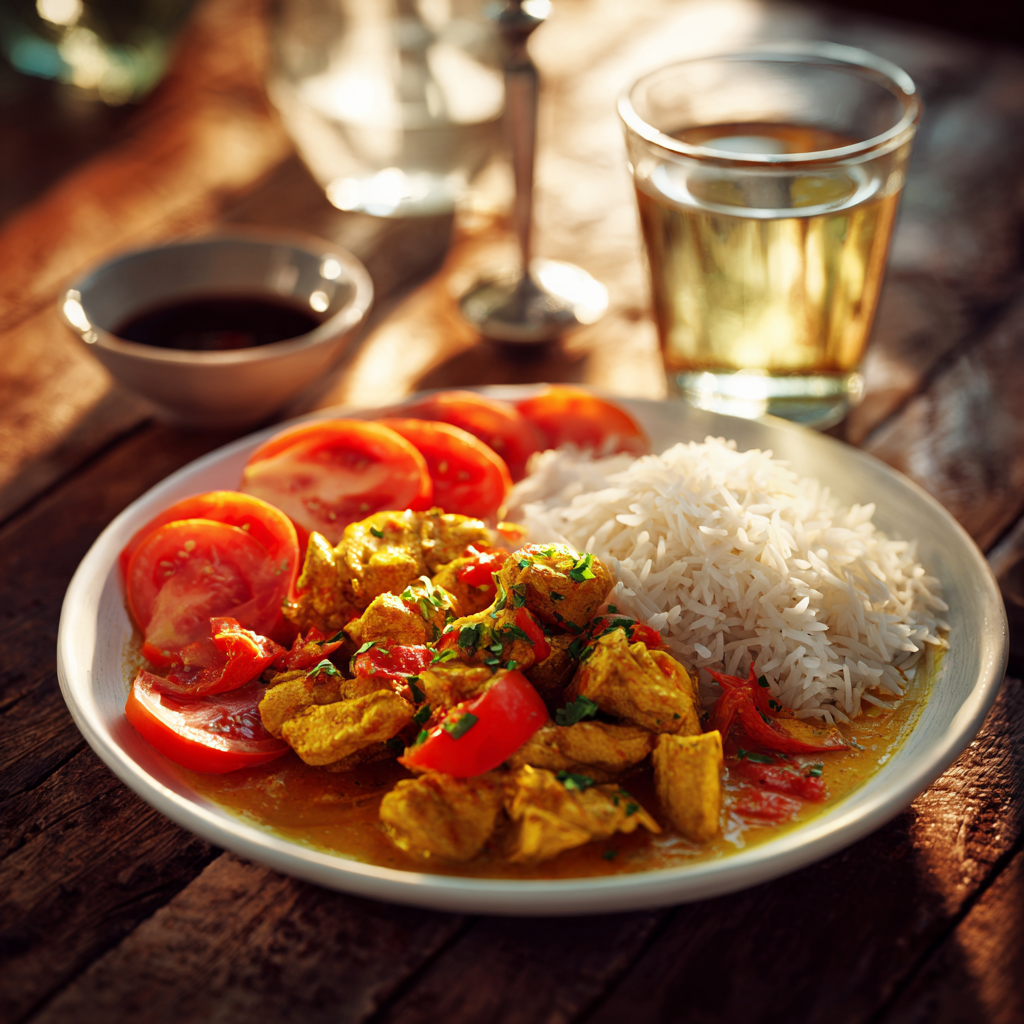Introduction
Picture this: a steaming bowl of chicken curry Filipino recipe sitting on the dining table, its aroma filling the entire house. I remember my Lola stirring her big pot of curry, humming an old folk song. Cooking was her way of showing love, and for me, it became a lifelong passion. There’s something magical about creating dishes that bring people together.
In Filipino cuisine, chicken curry holds a special place. It’s hearty, comforting, and full of flavor. Unlike other curries you might have tried, this dish has its own twist—thanks to our unique blend of spices and creamy coconut milk. In this guide, I’ll walk you through making a delicious chicken curry Filipino style at home. You’ll also find tips, variations, and answers to common questions like “What are the key ingredients in Filipino chicken curry?”
What Makes Chicken Curry Filipino Style Unique?
Filipino-style curry stands out because of its rich, creamy texture and balanced flavors. The secret lies in two key elements: spices and coconut milk. Here’s how they work together:
- Spices: We use turmeric, cumin, and curry powder. These give the dish its warm, earthy taste.
- Coconut milk: This adds creaminess and balances the heat from chili peppers.
Compared to Indian or Thai curries, Filipino chicken curry is milder but equally flavorful. Indian curries often rely on garam masala and yogurt, while Thai curries use lemongrass and green curry paste. Our version is simpler, focusing on easy-to-find ingredients like onions, garlic, and ginger. That’s why it’s sometimes called coconut milk chicken curry.
If you’re searching for a spicy chicken curry recipe, don’t worry—you can adjust the heat level to your liking. Add more chili peppers or keep it mild for kids. Either way, it’s sure to be a crowd-pleaser.
Why You’ll Love This Recipe
This chicken curry Filipino recipe is perfect for beginners and experienced cooks alike. Why? Because the ingredients are simple and easy to find. Most Filipino kitchens already have them stocked:
- Chicken thighs or drumsticks (they stay tender during cooking)
- Onions, garlic, and ginger (the holy trinity of Filipino cooking)
- Curry powder and turmeric (available in most grocery stores)
- Coconut milk (a must-have for authentic flavor)
I’ve made this dish countless times with my family. One of my favorite memories is teaching my niece how to sauté onions until golden brown. She was so proud when we sat down to eat. Moments like these remind me why food is so important—it connects us.
Let’s talk about the key ingredients in Filipino chicken curry. Each one plays a role in building layers of flavor:
- Chicken: Dark meat works best because it stays juicy.
- Coconut milk: Adds richness and depth.
- Curry powder: The star spice blend that gives the dish its name.
- Turmeric: Brings warmth and color.
- Ginger and garlic: Essential for that classic Filipino taste.
With these basics, anyone can whip up a tasty curry. Whether you’re craving comfort food or planning a family dinner, this recipe fits the bill. Plus, leftovers taste even better the next day!
Ingredients You’ll Need for Chicken Curry Filipino Recipe
Alright, let’s get into the nitty-gritty of what you’ll need to whip up this homemade Filipino chicken curry. Trust me, it’s not rocket science. Most of these ingredients are probably already in your pantry or easy to grab from the store. Here’s the rundown:
Protein: About a kilo of chicken thighs or drumsticks works like a charm. Why? They’re forgiving—meaning they stay juicy even if you overcook them slightly.
Aromatics: Three cloves of garlic, minced; one large onion, chopped; and a thumb-sized piece of ginger, sliced thinly. These are the backbone of almost every Filipino dish, so you better believe they’re essential here too.
Spices: You’ll need three tablespoons of curry powder (the star of the show), a teaspoon of turmeric for that golden glow, and a pinch of cayenne pepper if you want some kick. If you’re looking for an authentic spice blend, check out this detailed guide on Filipino curry spice mix.
Liquid base: One can (around 400ml) of coconut milk is non-negotiable. It gives the curry its creamy texture and balances all those bold flavors. But hey, I know some folks aren’t fans of coconut milk—or maybe they just ran out. Don’t worry! There’s a workaround using alternatives, which I’ll touch on briefly below. For more details, head over to the FAQ section later.
Veggies: A couple of potatoes and carrots will do wonders. Peel and cube them into bite-sized pieces. Not only do they add bulk to the dish, but they also soak up all that delicious sauce.
Seasoning: Soy sauce, salt, and black pepper round things off nicely. A splash of fish sauce isn’t mandatory, but oh boy, does it take the umami factor up a notch!
By the way, someone once asked me, “Can I substitute coconut milk in chicken curry?” The short answer is yes—you can use cream or even yogurt as a stand-in. However, the flavor profile won’t be quite the same. If you’re curious about how to make chicken curry without coconut milk, there’s a full recipe linked right there.
Step-by-Step Instructions for Making Chicken Curry
Now comes the fun part—actually cooking the dish! Whether you’re new to Filipino cuisine or a seasoned home cook, these steps will guide you through making a best chicken curry recipe that everyone will rave about.
1. Preparing the Chicken
First things first, give your chicken a good rinse under cold water and pat it dry with paper towels. This helps achieve a nice sear when you brown it later. Funny enough, my mom used to skip this step entirely because she was always in such a hurry. While it’s technically optional, browning the chicken adds depth to the flavor. Season it lightly with salt and pepper while you heat up some oil in a large pot or deep skillet.
2. Sautéing Aromatics
Once the chicken has been set aside, toss in the garlic, onions, and ginger. Sauté them until the onions turn translucent and the kitchen smells amazing. Pro tip: Don’t rush this step. Letting the aromatics soften slowly builds layers of flavor. Remember what I said earlier about teaching my niece to sauté onions? Well, patience pays off—it really makes a difference.
3. Adding Spices
Next, sprinkle in the curry powder and turmeric. Give everything a quick stir to coat the aromatics evenly. Toasting the spices for a minute or two releases their oils and intensifies their aroma. It’s kind of magical watching the raw powders transform into something fragrant and vibrant. At this point, your kitchen should smell like a cozy little corner of Manila.
4. Simmering Everything Together
Add the chicken back into the pot along with the cubed potatoes and carrots. Pour in the coconut milk and enough water to barely cover everything. Bring it to a gentle boil, then lower the heat and let it simmer uncovered for about 30–40 minutes. Stir occasionally to prevent sticking, especially near the bottom of the pot. During this time, the flavors meld together beautifully, creating a rich and hearty stew.
Here’s the thing: Timing matters. If you’re unsure how long to cook chicken curry, don’t stress too much. Just make sure the chicken is tender and the veggies are cooked through. Speaking of timing, did you know this method is similar to how Guyanese curry chicken is prepared? Check out this Guyanese curry chicken recipe for comparison—it’s fascinating how different cultures approach curry!
Tips for Perfect Chicken Curry Every Time
Let’s talk tweaks and tricks to elevate your easy curry chicken recipe. After years of experimenting, I’ve picked up a few pointers that might help you nail it every single time.
Adjusting Spice Levels
If you’re sensitive to heat, start small with the cayenne or omit it altogether. On the flip side, if you love fiery dishes, throw in an extra chili pepper or two. Personally, I like adding a dash of paprika for color without overwhelming spiciness. Balance is key here—it’s all about finding what suits your taste buds best.
Paring Suggestions
What goes well with chicken curry? Steamed white rice is the classic pairing, no doubt. But have you tried serving it with garlic bread? Sounds wild, I know, but trust me—it’s surprisingly satisfying. Another option is pairing it with plain boiled eggs for added protein. Filipinos often serve this dish during family gatherings, so feel free to experiment based on what you have on hand.
Cooking Time Matters
One common question people ask is, “How long should I cook chicken curry?” Ideally, aim for at least 30 minutes of simmering after combining all the ingredients. This ensures the chicken becomes fall-off-the-bone tender and the sauce thickens slightly. Overcooking isn’t usually an issue unless you let it dry out completely. Keep an eye on the liquid level and adjust accordingly.
And there you have it—a foolproof guide to creating a mouthwatering chicken curry recipe Philippines-style. With these tips and tricks, you’re ready to impress friends and family alike. Happy cooking!
Variations of Chicken Curry Filipino Recipe
Let’s be real—cooking is all about making a dish your own. With this chicken curry Filipino recipe, there’s so much room to play around and customize. I’ve seen people toss in bell peppers for a bit of crunch, swap potatoes for sweet potatoes, or even throw in green beans for extra color. One time, my cousin added pineapple chunks (yes, pineapple!) and it was shockingly good. The sweetness balanced out the savory spices perfectly.
If you’re looking to go meat-free, don’t worry—you can still enjoy this dish. A vegetable-packed chicken curry Filipino recipe works wonders with tofu or chickpeas as the star protein. Just pan-fry the tofu until golden before adding it to the curry, and let the sauce soak into those crispy edges. Chickpeas are another great option; they hold up well in the simmering sauce and add a hearty texture. Trust me, even meat-lovers won’t feel like they’re missing out.
By the way, if you’re aiming for something healthier, consider swapping white rice for cauliflower rice or quinoa. It’s lighter but still satisfying. And hey, why not experiment with different veggies? Zucchini, eggplant, or even spinach would work beautifully here. Honestly, the only limit is your imagination (and maybe what’s in your fridge).
Serving Suggestions and Storage Tips
Now that you’ve got your curry ready, let’s talk about how to serve it up in style. Garnishes might seem like an afterthought, but they can really elevate the dish. A handful of fresh cilantro sprinkled on top adds brightness, while a squeeze of lime juice gives it a zesty kick. Funny enough, I once forgot the garnish entirely during a dinner party, and someone pointed it out halfway through the meal. Lesson learned: presentation matters!
When it comes to leftovers—and trust me, you’ll want to make extra—proper storage is key. Store the curry in an airtight container in the fridge for up to three days. To reheat, gently warm it on the stovetop over low heat, adding a splash of water or coconut milk if the sauce has thickened too much. Microwaving works too, but stirring halfway through helps keep everything evenly heated.
Here’s a pro tip: Can you freeze Filipino chicken curry? Absolutely! Let it cool completely before transferring it to freezer-safe bags or containers. It’ll stay good for up to three months. When you’re ready to eat, thaw it overnight in the fridge and reheat as usual. For more details on freezing and reheating, check out the FAQ section below.
Frequently Asked Questions (FAQs)
- What is the difference between Filipino chicken curry and other curries?
Filipino chicken curry is milder and creamier compared to Indian or Thai curries. While Indian curries often use garam masala and yogurt, and Thai curries incorporate lemongrass and green curry paste, Filipino curry relies heavily on coconut milk and simple spices like turmeric and curry powder. It’s comforting, approachable, and perfect for beginners. - Is Filipino chicken curry very spicy?
Not at all! Most versions are mild, focusing on rich flavors rather than heat. If you prefer spice, you can always amp it up with chili peppers or cayenne. But honestly, even without the heat, it’s packed with flavor. - Where can I buy authentic Filipino curry spices?
Many Asian grocery stores carry Filipino-style curry powder. You can also find them online on platforms like Amazon or specialty websites. If you’re feeling adventurous, try mixing your own blend using turmeric, cumin, coriander, and a pinch of cinnamon. - Can I make this recipe in an Instant Pot?
Definitely! Use the sauté function to brown the chicken and aromatics, then switch to pressure cook mode for about 15 minutes. Natural release ensures the chicken stays tender. Easy peasy! - What sides pair best with chicken curry?
Steamed white rice is classic, but garlic bread or roti makes a fun twist. For a healthier option, try pairing it with roasted vegetables or a crisp salad. Honestly, anything that soaks up that delicious sauce is fair game. - How do I prevent the curry from being too watery?
Simmer it uncovered for a bit longer to reduce the liquid. Alternatively, mix a teaspoon of cornstarch with water and stir it into the curry—it thickens things right up. - Can I use boneless chicken instead of bone-in?
Sure thing! Boneless chicken cooks faster, though, so adjust your timing accordingly. Cut it into bite-sized pieces for quicker cooking and easier serving. - Why does my curry taste bland?
This could be due to under-seasoning or skipping the step of browning the chicken and aromatics. Toasting the spices also helps boost flavor. Taste as you go and adjust salt, soy sauce, or fish sauce to enhance the overall profile. - What’s the best way to store leftovers?
Keep it in an airtight container in the fridge for up to three days. For longer storage, freeze it in portions for easy reheating later. Always cool it completely before storing. - Can I substitute coconut milk with something else?
Yes, heavy cream or whole milk yogurt can work as substitutes. However, the flavor won’t be quite the same. Coconut milk brings a unique richness that complements the spices beautifully. For more ideas, visit our guide on chicken curry without coconut milk.
Speaking of variations, if you’re curious about other global takes on curry, you might love exploring recipes like Guyanese curry chicken. It’s fascinating how each culture puts its own spin on this beloved dish.
Final Thoughts
Cooking a chicken curry Filipino recipe isn’t just about following steps—it’s about creating memories. Whether you stick to the basics or get creative with your ingredients, the end result is always a dish filled with heart and soul. So grab your apron, gather your loved ones, and dive into the magic of Filipino comfort food. And hey, if you come up with a killer variation, share it in the comments—I’d love to hear from you!

Chicken Curry Filipino Recipe
Ingredients
Equipment
Method
- Rinse chicken under cold water and pat dry, then season lightly with salt and pepper.
- Heat oil in a large pot or deep skillet, then brown the chicken lightly.
- Remove chicken and sauté garlic, onion, and ginger until onions are translucent.
- Add curry powder and turmeric, toasting for a minute.
- Return chicken to the pot along with cubed potatoes and carrots.
- Pour in coconut milk and enough water to barely cover everything, then bring to a boil.
- Lower heat and let simmer uncovered for 30-40 minutes, stirring occasionally, until chicken and veggies are tender.


